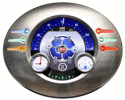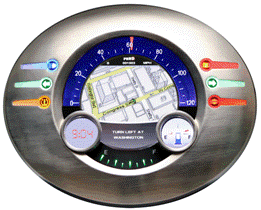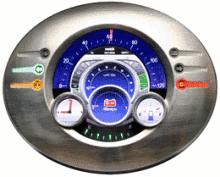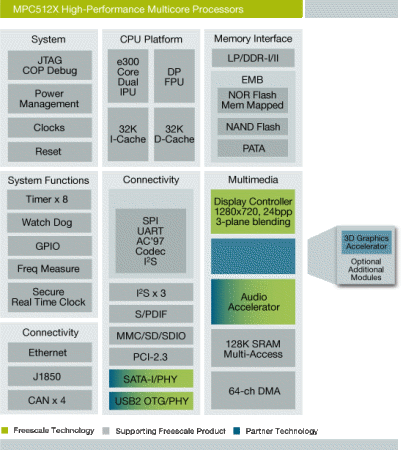Automotive gauge cluster design runs Linux
Jun 9, 2009 — by Eric Brown — from the LinuxDevices Archive — 47 views Automotive instrumentation provider Yazaki North America announced an instrument cluster display based on embedded Linux, designed for reconfigurable dashboard TFT/LCD displays. The instrument cluster prototype is built around a PowerPC-based Freescale MPC5121e system-on-chip (SoC), and offers 3D effects, says… the company.
Automotive instrumentation provider Yazaki North America announced an instrument cluster display based on embedded Linux, designed for reconfigurable dashboard TFT/LCD displays. The instrument cluster prototype is built around a PowerPC-based Freescale MPC5121e system-on-chip (SoC), and offers 3D effects, says… the company.
(Click for larger view of Yazaki's instrument cluster)
The design was a collaborative effort with Freescale Semiconductor, which furnished its telematics-focused MPC5121e SoC. The MPC5121e is built on 90nm CMOS technology for low power consumption, and integrates a 400MHz PowerPC, 2D/3D graphics core, and a programmable media-processing core optimized for real-time audio functions (see farther below for more information).

Yazaki's instrument cluster showing mapping display
Like Ford's new SmartGauge cluster designed for its 2010 Ford Fusion Hybrid, the Yazaki design offers a dynamic GUI interface to simulate analog instrumentation and report on a variety of telematics and related information in a small space. Yazaki offers a more three-dimensional effect by displaying indicators, fuel gauge, and speedometer information on different levels, as well as adding tunnels and a tapered bezel over the LCD, says Yazaki.


Additional Yazaki cluster views
(Click on either to enlarge)
The design is said to be highly customizable by automotive OEMs, enabling a wide range of dashboard designs for entry-level to high-end cars. When used in hybrids, the reconfigurable instrumentation can also display information such as driver and vehicle performance, as well as environmental impact.
The design supports integrated video input for displaying camera information, and the lighting system for the TFT/LCD display incorporates light guides, and uses a minimum number of LEDs “to offer styling flexibility and reduced complexity,” says Yazaki. Based on embedded Linux, presumably using Freescale's Linux development platform for its MPC processors, the firmware is also said to make use of the chip's OpenGL ES 1.1 graphics.

MPC5121e function block diagram
(Click to enlarge)
The 32-bit Freescale MPC5121e SoC is based on an e300 core clocked up to 400MHz. The chip integrates an XGA (1024 x 768) LCD controller, along with a PowerVR MBX Lite 2D/3D graphics core from Imagination Technologies. Additionally, a “fully programmable” 32-bit RISC-based multimedia acceleration core is said to accelerate the decompression of popular audio formats, including MP3, AAC, WMA, and Ogg Vorbis. It also supports key features for speech recognition and in-vehicle hands-free applications based on Bluetooth, including sample rate conversion, noise reduction, and acoustic echo cancellation.
The MPC5121e primarily targets “next-generation” telematics systems, such as in-car infotainment, driver assist devices, and digital displays for intelligent dashboards. In October 2007, Wind River, which is scheduled to be acquired by Intel this summer, announced a partnership with Freescale to co-develop a Linux development kit for the SoC. Last year, Freescale shipped a dual-core verson of the SoC called the MPC5123.
Stated Michael Boyd, product manager at Yazaki, “This successful joint development effort combined Freescale's silicon and software expertise with our extensive experience in designing and producing a broad range of instrument cluster products for automotive OEMs worldwide.”
Stated Ray Cornyn, director of automotive microcontrollers at Freescale, “Yazaki's new instrument cluster platform brings fresh innovation to displays for the next generation of driver-friendly vehicles.”
Availability
No information was offered on the availability of the Yazaki instrument cluster. More information may be found here.
This article was originally published on LinuxDevices.com and has been donated to the open source community by QuinStreet Inc. Please visit LinuxToday.com for up-to-date news and articles about Linux and open source.